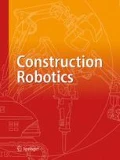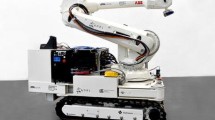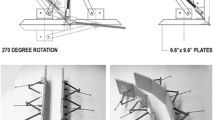Abstract
This research demonstrates a new methodology—stack casting, which combines fabric formwork and robotic assembly. In the following research, a robot placed a textile mold on top of a precast environment to erect a significant architectural object. Through this method the robotic casting process obtained further contextual information to create highly customized assemblies. The natural form-fit boundary of the fabric strengthened the identification between global and local systems. As the digital method met the natural form-finding process, an interactive tectonic was generated—calibrating itself for any composition and accommodating deviations in geometry. Driven by the correspondence between digital and physical, the technique extended the building method of a dry-fitted cast in situ wall. To build a full-scale prototype, robotic stack casting collaborated with other versatile methods to invent new set-up strategies, which link to both on-and off-site construction. This research is part of a bigger picture rising in soft robotics. By interpreting unique forming into the computational design, precise and imprecise fabrication were redefined in a playful phenomenon. In traditional robotic stacking, the robot bridges the digital and physical world but its lack of adaptivity causes problem when placing imprecise objects. In this research’s process, the use of inexact fabric molds fixed the tolerance and found centers of gravity through relative reactions. They adjusted to the unique personal properties of their surroundings and compensated for discrepancies in material. As an alternative to the application of sensor feedback for accommodating tolerance in material, the use of stack casting digital formwork instead adjusts and reshapes the non-ideal masonry from the real-time architectural context. This playful process opens the door to further imaginations from design to build.



















Similar content being viewed by others
References
Clifford B, McGee W, Muhonen M (2018) Recovering cannibalism in architecture with a return to cyclopean masonry. Nexus Netw J 20:583–604
Kudless A (2011) Bodies in formation—the material evolution of flexible formworks. Comput Aided Des Archit (ACADIA) 31:98–105
Sarafian J, Culver R, Lewis TS (2017) Robotic formwork in the MARS Pavilion—towards the creation of programmable matter. Comput Aided Des Archit (ACADIA) 37:522–533
Veenendaal D, West M, Block P (2011) History and overview of fabric formwork—using fabrics for concrete casting. Struct Concr 12:164–177. https://doi.org/10.1002/suco.201100014
West M, Allen E, Ochsendorf J, Veenendaal D, Caceres RA (2017) The fabric formwork book—methods for building new architectural and structural forms in concrete. Routledge, London
Acknowledgements
Precise Imprecision was made possible by the technical support from the FABLab at Taubman College, University of Michigan, and the funding support from the Precast/Prestressed Concrete Institute (PCI) Foundation. This project is a capstone design project from the MSDMT program, which is led by the advisor Prof. Glenn Wilcox. The robotic control utilizes Super Matter Tools (SMT) developed by Prof. Wes Mcgee as a plug-in interface for Rhinoceros 6. Additional support was received from Shan-Chun Wen and Julia Hunt. FABLab: Asa Peller, Carlos Pompeo, and Rachel Henry. MSDMT program: Prof. Catie Newell.
Author information
Authors and Affiliations
Corresponding author
Additional information
Publisher's Note
Springer Nature remains neutral with regard to jurisdictional claims in published maps and institutional affiliations.
Electronic supplementary material
Below is the link to the electronic supplementary material.
Rights and permissions
About this article
Cite this article
Ko, L.YL., Lo, E.HF. Precise imprecision: flexible construction with robotics. Constr Robot 4, 85–95 (2020). https://doi.org/10.1007/s41693-020-00032-x
Received:
Accepted:
Published:
Issue Date:
DOI: https://doi.org/10.1007/s41693-020-00032-x




